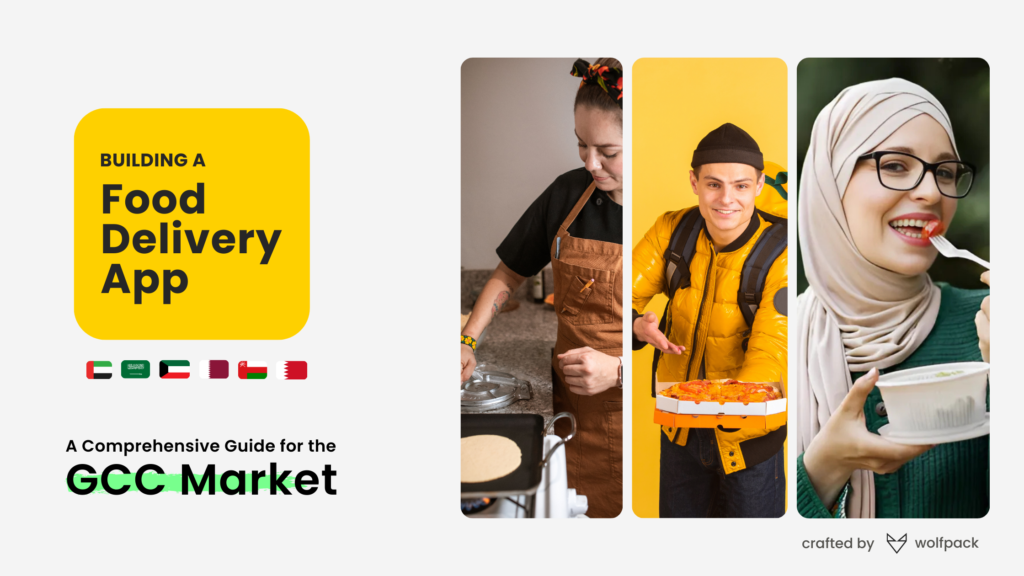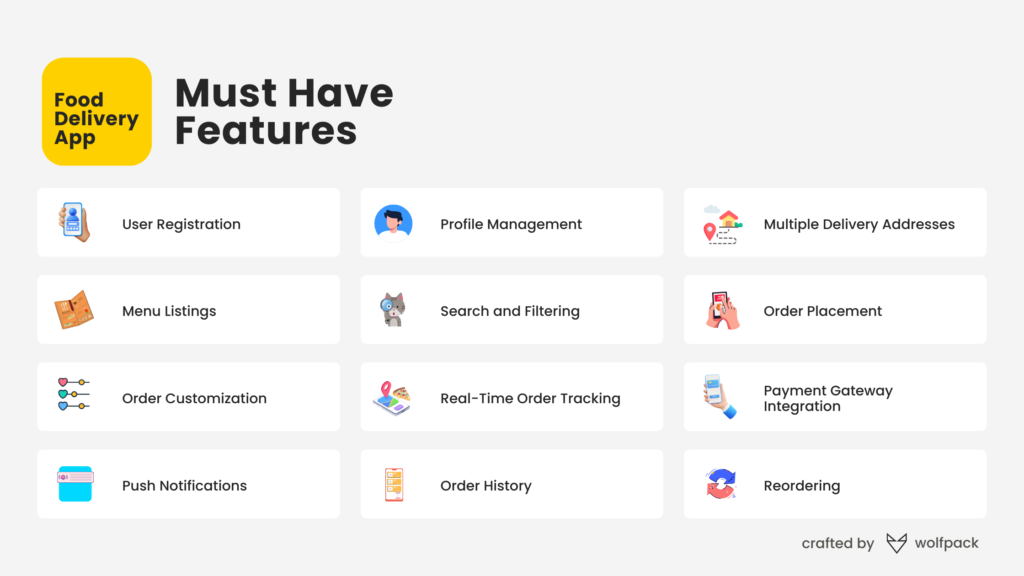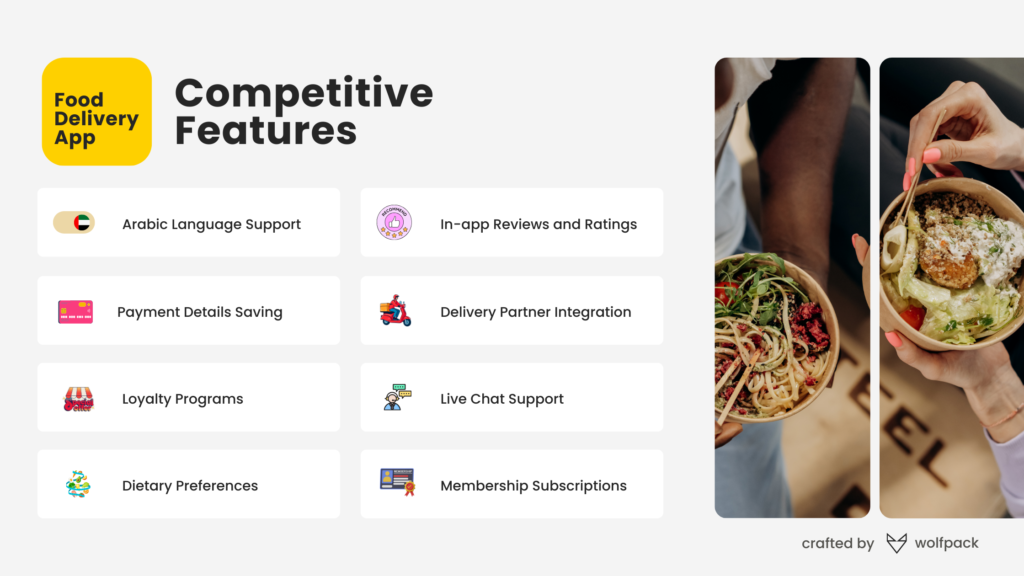Building a Food Delivery App: A Comprehensive Guide for the GCC Market

The food delivery industry has witnessed exponential growth, particularly in the GCC, where convenience and speed are paramount. With a vibrant mix of cultures, the region boasts a rich culinary landscape, influenced by a diverse population of expatriates from Asia, Europe, the Middle East, and Africa. In Dubai alone, the culinary industry encompasses approximately 13,000 restaurants and cafés, making it a paradise for food lovers and an exciting hub for delivery services. Apps like Talabat, Deliveroo, and Uber Eats have revolutionized dining experiences by enabling users to order food at the click of a button. In fact, the online food delivery market in the GCC was valued at approximately $4.8 billion in 2021 and is projected to reach $8.3 billion by 2027, growing at a CAGR of 10.2% during the forecast period . This indicates robust demand for food delivery services across countries like the UAE, Saudi Arabia, Kuwait, Bahrain, Oman, and Qatar.
For many in the GCC, food is not just a means of sustenance but a vital part of their cultural identity and social interactions. As various cuisines and dining preferences blend, the demand for accessible food delivery options continues to rise. If you’re considering developing a food delivery app to enter this lucrative market, understanding the costs associated with creating a competitive platform is essential. This article will break down the various factors influencing the cost of building a food delivery app and provide insights into expected expenses.
Current Landscape of Food Delivery Apps
The food delivery landscape in the Gulf Cooperation Council (GCC) region has become highly competitive, with several apps vying for market share.
In the UAE, Talabat dominates with over 60% of the food delivery market share. Deliveroo and Uber Eats are also notable competitors, with Uber Eats capturing around 12% of the market, while Deliveroo focuses on premium restaurants and has seen steady growth.
In Saudi Arabia, key players include Talabat, which maintains a strong presence, followed by HungerStation, a local favorite, and Jahez, which is quickly gaining traction among users.
In Kuwait, Talabat remains a significant player, serving as a one-stop shop for ordering food online in Kuwait and other GCC countries. However, Get Dukan has emerged as Kuwait’s first multicultural app, delivering food and groceries from various cuisines, including Indian, Pakistani, Filipino, Japanese, Bangladeshi, Egyptian, Nepali, and Korean, while also offering daily discounts and promotions. Additionally, Cari delivers food from popular restaurants such as Starbucks, Hardee’s, KFC, and Trolley.
In Qatar, there has been a surge in demand for food delivery services, with Talabat and Snoonu leading the charge as top contenders, with Snoonu being known for its fast delivery service. Deliveroo also remains a significant player in the market.
In Bahrain, Talabat continues to be a leading player in the food delivery market, alongside Ahlan, which is known for its diverse range of restaurant partnerships and user-friendly interface.
In Oman, Talabat remains a dominant force, complemented by HungerStation and Yemeksepeti, both of which have been gaining popularity for their extensive restaurant options and reliable delivery services.
According to a Statista report, the average revenue per user (ARPU) for online food delivery services in the UAE is around AED 650, reflecting the potential profitability of this sector. As smartphone usage continues to rise across the GCC, the appetite for convenient food delivery options will likely drive further expansion of these apps in the region.
The Cost of Building a Food Delivery App in GCC: An In-Depth Analysis
When developing a food delivery app in the Middle East, costs typically range from AED 35,000 to AED 100,000 or more. This range is influenced by several key factors:
- Complexity and Features of the App
- Technology Stack Utilized
- Development Team Composition
- Timeline for Development
1. Complexity and Features of the App
The complexity of your app plays a significant role in determining the overall development costs. To help you understand better, let’s break down the features into three categories: essential, competitive, and advanced.
Essential Features
These functionalities are critical for delivering a seamless and functional food delivery experience. In the well-established Middle Eastern market, customers expect a baseline of features to simplify ordering and enhance user experience:
- User Registration & Profile Management: Users should be able to create accounts, manage their personal details, and set preferences, including saved addresses for faster future orders. This also allows for personalized experiences, such as customized meal recommendations.
- Multiple Delivery Addresses: Users should be able to add and save multiple delivery addresses (e.g., home, office), making it convenient to choose where orders should be sent.
- Menu Listings:
- For Aggregator Apps: Apps featuring multiple restaurants must provide comprehensive listings with detailed menus, high-quality photos, ratings, and robust search filters (by cuisine, location, price, etc.), helping users discover exactly what they want.
- For Single Restaurant or Chain Apps: Focus on a well-designed, easy-to-navigate menu with clear descriptions, enticing images, and potential customization options for dishes. You can learn more about building a dedicated app for your restaurant chain or cloud kitchen in our guide: “How to Build A Cloud Kitchen App: A Beginner’s Guide.”
- Search and Filtering Options: Allow users to easily find their preferred meals or restaurants through search and filtering by criteria like cuisine, dietary preferences, location, or price range.
- Order Placement & Customization: An intuitive and user-friendly ordering process, where customers can customize their meals (such as adding extra toppings or specifying dietary needs), significantly enhances satisfaction and reduces errors.
- Real-Time Order Tracking: Enable GPS tracking for users to follow the status of their orders, from preparation to delivery. This transparency builds trust and improves the overall customer experience.
- Payment Gateway Integration: Offer multiple secure payment options, including credit/debit cards, mobile wallets, and cash on delivery (COD). Popular Middle Eastern gateways include Telr, PayTabs, 2Checkout, and CashU.
- Push Notifications: Send real-time updates to users for order confirmations, estimated delivery times, promotions, and special offers. These notifications keep users engaged and informed.
- Order History and Reordering: Keep a record of users’ past orders, allowing them to easily reorder their favorite meals with just a few clicks. This feature improves convenience and encourages repeat business.
Note: Ensure that the app complies with GCC regulations and standards, which may include data protection laws, food safety requirements, and digital payment security protocols.

Competitive Features
These features differentiate your app from competitors and significantly improve user engagement. In the Middle East’s increasingly competitive market, such features help foster loyalty:
- Arabic Language Support: Offer your app in both Arabic and English to ensure inclusivity for users across the GCC. This enhances accessibility and improves the user experience for both Arabic-speaking and English-speaking customers.
- In-app Reviews and Ratings: Encourage users to leave feedback on their meals and restaurants. Ratings and reviews not only help guide new customers but also allow restaurants to improve their service based on customer input.
- Payment Details Saving: Allow users to securely store their payment information for quicker checkouts. This reduces friction in the purchase process and enhances user convenience for future orders.
- Loyalty Programs: Reward loyal customers through points, discounts, or exclusive offers for frequent orders. This feature encourages repeat business and customer retention, giving users incentives to stay with your platform.
- Live Chat Support: Offer real-time customer support to assist users with their inquiries, complaints, or issues during the ordering process. This level of responsiveness can improve satisfaction and encourage users to return to your platform.
- Delivery Partner Integration: Collaborate with hyperlocal delivery services to expand your delivery reach and ensure faster fulfillment. This integration improves delivery efficiency, offering quicker and more reliable service to users.
- Dietary Preferences: Allow users to set dietary restrictions (such as vegan, gluten-free, or halal) in their account settings. The app will then filter the available meal options to display only those that match their preferences, providing a more tailored user experience.
- Membership Subscriptions: Introduce a subscription model offering exclusive perks such as free delivery, priority support, and member-only discounts. This creates an additional revenue stream while giving premium benefits to your most loyal users.

Advanced Features
These innovative features are designed to take your app to the next level, offering unparalleled experiences to both customers and restaurants. Incorporating these features can give you a substantial edge in the market:
- AI-powered Meal Recommendations: Use artificial intelligence to analyze user preferences, order history, and dietary restrictions to suggest personalized meal options. This feature enhances the overall customer experience by offering highly relevant recommendations.
- Meal Subscription Plans: Offer meal subscriptions where users can pre-select meals for daily or weekly delivery. This feature is gaining popularity, especially for health-conscious consumers or busy professionals looking for convenience. For more details, see our blog: How Meal Subscription Apps Are Outsmarting Instant Food Deliveries.
- Goal Setting & Calorie Tracking: Users can set personal health goals and track their caloric intake through the app. This feature is particularly attractive to health-conscious users, enabling them to make informed food choices based on their nutritional needs.
- Calorie & Nutrition Information: Display detailed calorie and nutrition breakdowns for each menu item, allowing users to make healthier choices. This feature adds transparency and helps users stick to their dietary goals.
- Custom Push Notifications: Tailor notifications to individual user preferences, sending personalized offers based on past orders, location, or upcoming events. These targeted messages are more likely to engage users and drive conversions.
- Voice Search Integration: Offer voice-activated search for users who prefer hands-free operation. This innovative feature can enhance the user experience, especially in an increasingly mobile-first world.
- Augmented Reality for Restaurants: Enable AR features to showcase restaurants or meals virtually. Users can visualize how their meal will look, or explore a restaurant’s ambiance through augmented reality, adding an interactive layer to the experience.
- AI-Powered Route Optimization for Delivery: Implement AI-based route optimization for delivery drivers to ensure the quickest delivery times and improve operational efficiency, benefiting both users and delivery partners.
2. Technology Stack Utilized
The choice of technology stack significantly impacts the overall development costs of a food delivery app. The stack comprises both the front-end and back-end technologies, databases, and tools required to build and maintain the app. Depending on your specific needs, here are some popular technologies to consider:
Front-end (User Interface)
Native Development: Using Swift or Objective-C for iOS and Java or Kotlin for Android, native development offers optimal performance and a seamless user experience by granting complete access to device-specific features. However, it necessitates separate development efforts for each platform, leading to increased costs and extended development timelines.
Cross-Platform Solutions: Frameworks like React Native and Flutter enable developers to write code once and deploy it across both iOS and Android platforms, significantly reducing development expenses and accelerating time-to-market. Yet, these frameworks may encounter performance limitations, particularly for intricate UI components or animations, and might lack full access to all native device functionalities.
Hybrid Approach: Some organizations adopt a hybrid model, launching their applications with a cross-platform framework to expedite market entry. As the application evolves, they gradually transition essential components to native code. This approach effectively balances cost efficiency with the desired performance and user experience.
Back-end (Server-side)
Node.js: This JavaScript runtime is fast, scalable, and event-driven, making it perfect for real-time applications.
Python: A versatile and user-friendly language, Python offers powerful frameworks like Django and Flask that facilitate rapid development.
Ruby on Rails: Known for its productivity and developer-friendly environment, this convention-over-configuration framework streamlines the development process.
Database
Traditional Relational Databases: PostgreSQL and MySQL are optimal for structured data with defined relationships, such as customer profiles and order histories.
NoSQL Databases: Solutions like MongoDB provide flexibility for managing unstructured or dynamically changing data, such as menus and real-time updates, often featuring a serverless option that simplifies scaling and reduces operational overhead.
Cloud Services
Major Providers: Industry leaders like Amazon Web Services (AWS), Google Cloud Platform (GCP), and Microsoft Azure offer extensive service suites and robust infrastructures to scale applications effectively.
Developer-Friendly Platforms: Platforms such as Heroku and Render are recognized for their ease of use and simplified deployment processes, making them ideal for smaller projects or teams with limited DevOps experience.
Other Options: Alternatives like DigitalOcean, Linode, and Vultr deliver affordable cloud hosting solutions with varying degrees of managed services.
Geolocation
Google Maps API, Mapbox: These tools are crucial for real-time driver location tracking and accurate delivery time estimates.
Payment Gateways
In the GCC, food delivery apps need to integrate region-specific payment gateways to cater to local preferences. Telr, widely used in the UAE, supports multi-currency transactions and offers various payment methods. PayTabs is another popular choice across the MENA region, known for its seamless integration and support for local currencies. Additionally, CashU, a leading digital wallet, ensures secure payments across the GCC, and 2Checkout provides global coverage with recurring billing capabilities.
Local solutions like Tap Payments, which integrates regional methods, and HyperPay, commonly used in Saudi Arabia, enhance transaction security. For Saudi Arabia, Mada, the national payment network, plays a significant role by facilitating compliant and efficient local transactions. These gateways ensure a secure and efficient range of payment options tailored to the GCC market’s needs.
SMS and WhatsApp Integration
Effective communication is crucial for food delivery apps to keep customers informed about their orders. Bulk SMS services are essential for sending order confirmations, updates, promotional messages, and OTPs (one-time passwords), ensuring timely communication. In the GCC region, several providers offer robust SMS and WhatsApp Business API solutions to facilitate this interaction.
In the UAE, providers such as SMSala, SMSCountry, and SMS Global enable food delivery apps to leverage both SMS and WhatsApp for effective customer engagement. MXT serves the Saudi Arabian market with similar offerings. Additionally, global providers like Twilio, Infobip, and Vonage offer scalable APIs that support both channels across the GCC region.
What Tech Stack Powers Talabat and Deliveroo?
In the GCC, Talabat and Deliveroo are dominant food delivery platforms that have built robust systems to manage millions of users and orders daily. Here’s a closer look at the key technologies they use:
Talabat’s Tech Stack
- Backend Technologies: Talabat relies on Node.js and Java for scalable, event-driven backend services. For high-performance microservices, they also employ Go.
- Frontend Technologies: The web interface is powered by React.js and Angular, enabling dynamic and user-friendly applications.
- Mobile Development: Both React Native (for cross-platform compatibility) and native development with Swift (iOS) and Kotlin (Android) are used to enhance mobile performance.
- Database: MySQL serves as the primary relational database, while MongoDB is employed to handle unstructured data, particularly useful for real-time data updates.
- Cloud Services: Amazon Web Services (AWS) provides cloud hosting, storage, and services for scalability.
- Additional Services: Elasticsearch powers efficient search functionalities, and Redis helps optimize caching for faster load times.
Deliveroo’s Tech Stack
- Backend Technologies: Deliveroo uses Python and Ruby on Rails for its API-driven backend. These frameworks ensure smooth order processing and API responses.
- Frontend Technologies: React.js drives their user-friendly web applications.
- Mobile Development: Like Talabat, Deliveroo focuses on native mobile app development with Swift (iOS) and Java/Kotlin (Android), ensuring a high-quality user experience.
- Database: PostgreSQL is used as the primary relational database for structured data, while Redis assists with caching and real-time data handling.
- Cloud Services: AWS is the go-to platform for cloud computing and hosting.
- Additional Services: Apache Kafka handles real-time data processing and analytics, while Docker is used for containerization to streamline deployments.
3. Development Team
The structure and location of your development team will significantly influence both the cost and timeline of your project. In the GCC region, there are several options to consider:
- Freelancers: For small projects or specific tasks, hiring freelancers can be a cost-effective solution. However, coordinating and managing multiple freelancers, especially across different locations, can require additional effort. While this option may work well for short-term needs, it may lack the reliability and long-term commitment required for larger or more complex projects.
- Local Agencies: Local development agencies in the region offer full-service packages, from design and development to testing and deployment. These agencies are adept at working within regional regulations and consumer expectations, ensuring that projects are completed on time and to a high standard. However, these services often come at a higher cost due to local operating expenses.
- Outsourcing: Outsourcing to countries like India has become an increasingly popular option for GCC businesses seeking high-quality development at lower costs. India is a global leader in IT services, and companies like Wolfpack offer specialized app development expertise to clients in the GCC.
With a dedicated team based in India, we provide comprehensive solutions, ensuring seamless communication, effective project management, and cost-efficiency. Outsourcing to India allows GCC businesses to tap into a highly skilled talent pool while keeping operational costs under control. This approach requires careful management to ensure alignment and timely delivery, but the cost-benefit is significant for businesses aiming to scale.
- In-House Team: Establishing an in-house development team provides maximum control over the project but also demands significant investment in recruitment, training, and ongoing management. This option is typically more feasible for larger companies with the infrastructure to support a dedicated tech team. Additionally, in the GCC, attracting and retaining top talent may be challenging due to competitive compensation requirements.
4. Development Timeline
The development timeline for a food delivery app depends on the complexity and range of features desired. While a Minimal Viable Product (MVP) can be completed within weeks, a fully comprehensive app—complete with features like multiple payment gateways, multilingual support, and advanced user analytics—may take longer, typically around 3-4 months for the first phase.
At Wolfpack, we focus on delivering results efficiently. The first phase of your food delivery app, including essential features, will be completed and launched within just 8 weeks. This allows you to start attracting users and generating revenue. After the initial launch, we continue enhancing the app by adding advanced features and refining the user experience, which can take up to 3 to 4 months for the complete development cycle.
How Much Does It Really Cost to Build a Food Delivery App Like Deliveroo or Talabat in the GCC?
The cost of developing a basic food delivery app with essential features in the GCC typically starts from AED 35,000 to AED 50,000 and usually takes 2-3 months to develop. For those looking to add more advanced features, a mid-range app can cost between AED 75,000 to AED 100,000, with a development timeline of 4-6 months. If you’re aiming for a comprehensive solution with all the necessary functionalities, expect to invest between AED 150,000 to AED 200,000, which may take 6-12 months or more to fully develop.
These figures are rough estimates; actual costs will depend on your specific requirements, the complexity of the design, the chosen technology stack, and the rates of your development team.
Ongoing Costs for Maintenance and Marketing
It’s crucial to remember that the initial development cost is just the starting point. You should also account for ongoing expenses, including:
- Maintenance: Allocate 15-20% of the initial development cost annually to cover updates, bug fixes, and new feature additions.
- Marketing & Acquisition: Attracting users and partnering with restaurants requires investment in digital marketing, promotions, and potentially traditional advertising.
Tips for Cost Optimization
- Start with an MVP (Minimum Viable Product): Focus on the core features to launch quickly and gather user feedback.
- Consider White-Label Solutions: Companies like Jungleworks, RestroApp, and Yelo provide customizable white-label solutions that can be more cost-effective than building from scratch.
- Prioritize Features Wisely: Avoid overcomplicating your app at the start. Concentrate on features that provide the most value to your users.
Next Steps
To get a precise estimate for your app, reach out to experienced app development agencies or freelancers. They can assess your unique requirements, provide a detailed breakdown of costs, and guide you through the development process. Remember, building a successful food delivery app is more than just the app itself; consider marketing, operations, customer support, and other associated costs as you plan your venture.
Partner with Wolfpack to Bring Your Food Delivery App Vision to Life
Ready to embark on your food delivery app journey? Don’t navigate the complex world of app development alone. Partner with Wolfpack, a leading app development agency in India, to bring your vision to life.
At Wolfpack, we specialize in creating high-quality, user-friendly food delivery apps tailored to your specific needs and budget. Our experienced team will guide you through every step of the process, from conceptualization and design to development, testing, launch, and ongoing maintenance.
Contact Wolfpack today for a free consultation and a personalized quote!
